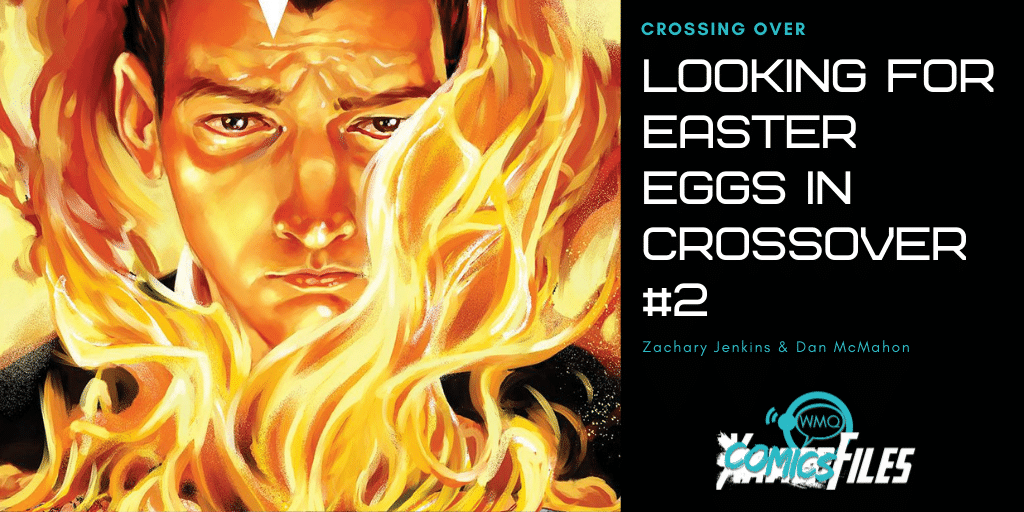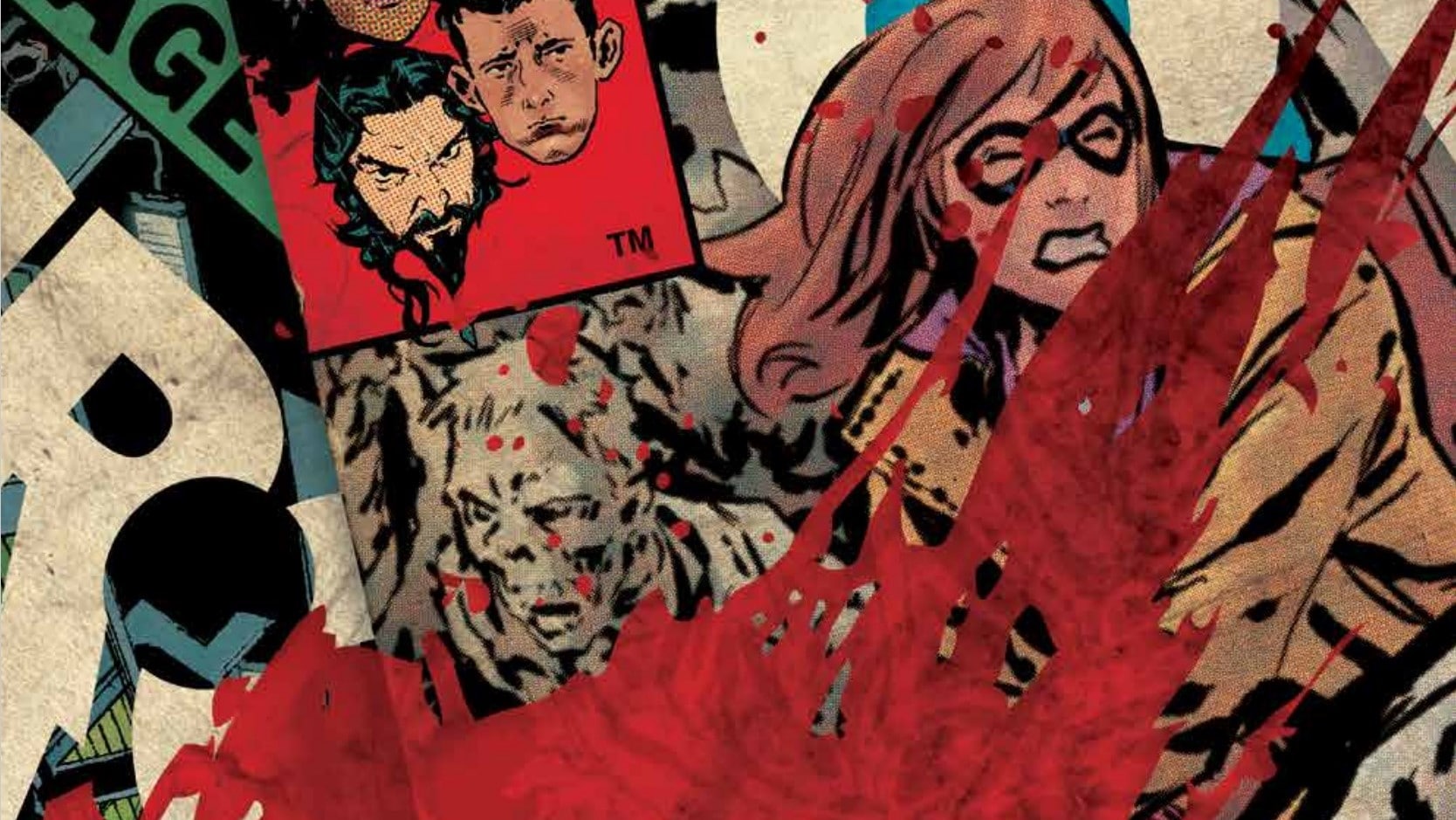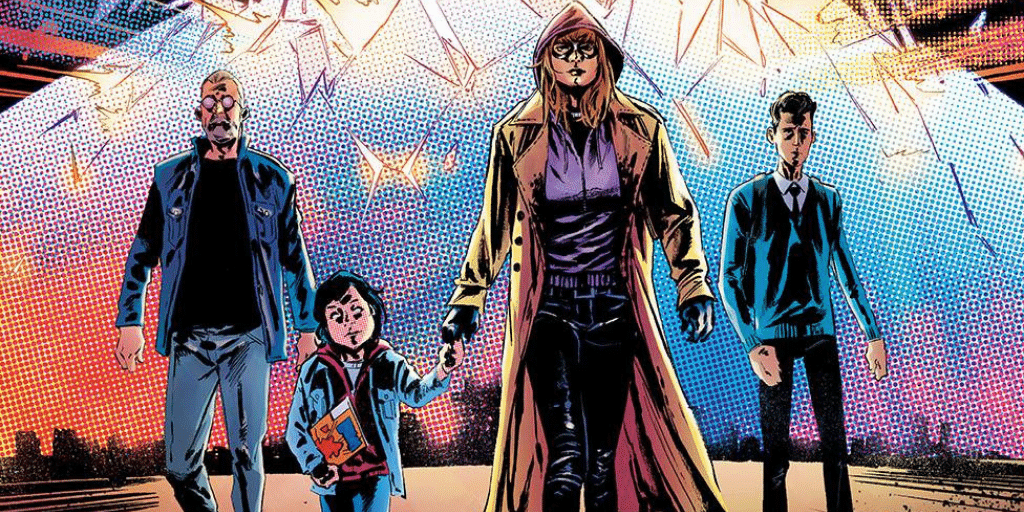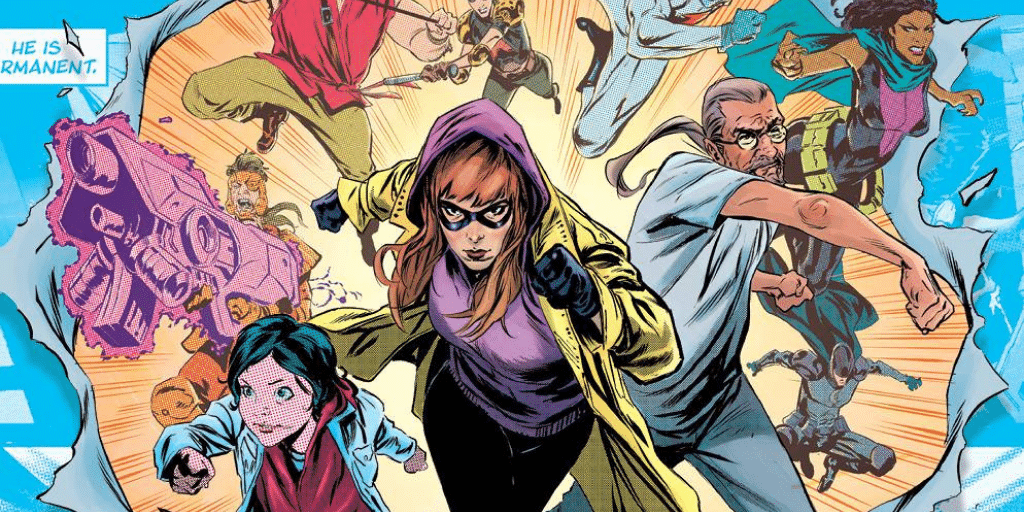The event continues to unravel as Ellie, Otto and Ava rise from the ashes of their comic shop to begin their four-color odyssey to find the truth beyond the dome. Meanwhile: Super-prisons! Magic guns! Mysterious government agents! And other stuff! Zachary Jenkins and Dan McMahon break down Image’s Crossover #2 by Donny Cates, Geoff Shaw, Dee Cunniffee and John J. Hill.

Zachary Jenkins: Crossover #2 is here, right on the heels of Cates’ actual lowercase crossover, The King In Black. Do you want to talk about it, Dan? Because I am ready, player one!
Dan McMahon: I see what you did there, Zachary, you made a reference. Most often referred to as an Easter egg, where you reference something in pop culture. It’s so hot right now.
Remember That?
ZJ: If there is one thing this comic wants you to do, it’s remember a different comic. When the first issue came out, I compared it to a “Family Guy cut-away gag,” but that’s not it, not really. Instead this feels more akin to the recently released Ready Player Two. It’s intent on making a reference, then making it perfectly clear what the reference is. This chapter opens with a string of name drops, and then makes it known why we should recognize them, as well as making the audience feel superior for knowing all-star crossover creators like Brian K. Vaughan for their incredibly successful Image work and not, say, their time working for the Big Two. Subtle this book is not.

DM: Honestly, when they were talking about how Vaughan was remembered for certain work instead of his hits, I laughed. I did think that was a good bit.
Something that socked me across the face and laid me out on the floor was the jail scene. I am not a big Spawn reader, but I was in high school when I was EDGY. So the allusion to that Spawn double page spread where all the Marvel and DC heroes’ hands reach out for him to save them was clear as day in this issue. To me, that scene was a reflection of Image itself in Spawn. The founders had all just broken away from the Big Two to do something new. But this feels way more “Look at us using these characters,” which doesn’t really have much to say. I will be honest, I smiled though when I saw it. I’m the kind of goofball that loves when a comic references the “other teams.” I get a big dumb smile on my face, and I appreciate it here in places. But at some point, you realize you cannot build a story on bones that are made of cotton candy. Sure, it’s fun to see a Power Ranger hand in an Image book, but that appeal is just pure sugar and leaves you with a headache after a bit.
ZJ: There’s such a “wink and nod” attitude to this whole sequence. It knows that you’re going to recognize that famous moment from Spawn #10 [Grote’s note: Is that moment famous? I’d honestly never seen it until people started dunkin’ on Donny about it this week, and I lived through Spawn-mania. I LIVED THROUGH IT.]. What the reference here loses is the context of that moment. That issue is titled “Crossing Over” and is written by Dave Sim. It features Spawn, the iconic Image character, and Cerebus the Aardvark, the symbol of the black-and-white funny animals boom of the ’80s. It shows classic Marvel & DC characters in hell, slaves to their corporate masters. It’s a rebellious middle finger to the commercial comics industry from creators who had had enough.
For all his presentation as a rebel or the bad boy of comics, Donny Cates’ name is the single biggest draw at Marvel, and he is currently headlining its big commercial anchor for Q4. He’s evoking a punk attitude while filling the coffers of Mickey Mouse.
DM: We have to talk about the green rock in the room. That bullet is definitely kryptonite, right? The punk who threw the molotov into the comic shop, Ryan, is recruited by a mysterious government worker (who has so many Easter eggs in his office). He gives Ryan a letter that was written by a nameless psychic comic character. But the letter is from Ellie, the main protagonist that we know he will fall in love with. It all just doesn’t click for me yet. It’s a lot of the same complaints I have about issue #1.
ZJ: As much as I hate the reference-heavy stuff, I think the kryptonite works. The difference is that the concept of kryptonite is greater than comics or the genre. It is pop culture shorthand for a weakness, much in the same way we think of an Achilles heel. It’s a common assessment that superheroes have become modern mythology. It’s one I think has a lot of merit. Literalizing that mythology in a story that attempts to subvert or comment on the genre is a pretty neat trick. It just doesn’t feel earned as the climax of a scene referencing another scene, that itself is referencing a more classical work. If this same thing was pulled in a book like Flex Mentallo, I’d probably eat it up.
Maybe that says more about what I’m bringing to this book than anything else.
Pop Art

DM: I do want to address something I have seen online — that all we do is crap on this book. I don’t think this book is all bad. The art is honestly something I really looked forward to after finishing issue #1. Geoff Shaw’s art matched with Dee Cunniffe’s coloring is just beautiful to look at. Something that stands out so much is the distinct style given to each of the characters from the other worlds. Even if it’s only for a single panel, the attention to detail in the way Spawn and Spider-Man are drawn is very evocative of Todd McFarlane. The art of this book is downright gorgeous, and I don’t want to underestimate that.
ZJ: Shaw is doing fantastic work on this book. Image Comics was founded by a group of artists, not writers. They sold books based on their explosive designs and groundbreaking action. Shaw upholds that tradition, but in a tweaked way. The nature of this book requires him to be reserved. Emotive character action and quiet glances between Ellie and Otto form the backbone of this title, where chains and pouches uplifted the original Image books. It’s really stellar stuff.
Similarly, the colors are evocative. The sickly green that radiates from the prison cells helps underline the sense of weakness in that room. The textures Cunniffe applies are most obvious on the superheroes, but the technique applies, in a more subdued way, to the “normal” people. It helps add a ton of depth to the art. For as much as that bothers me about the writing in this one, the art isn’t letting anyone down.
The Camps
ZJ: There was one other thing that irked me this week. I don’t want these discussions to be a referendum on all things Donny Cates. I think it’s important to put some distance between art and artist. Like most things that irk me in a given week, it started with a tweet. This one actually:
I point this out not to say that everything Cates writes needs to be a political manifesto — look at the aforementioned Cerebus to see how well that goes — but instead to say that this colors the main plot of Crossover in a pretty negative light. You see, we learn the young girl from the dome is named Ava Quinn. And we learn that the folks from the other side of the crossover have been rounded up into “The Camps,” where they are abused and experimented on. Visually, these evoke ICE detention centers and the rallying cry of “kids in cages.” Thematically, it reminds us of monsters like Josef Mengele, monsters who exist in living memory.
Cates seems more than happy to make these references, much in the same way he makes references to the intellectual property of Disney and AT&T. However, this feels inappropriate when he is evoking the pain and horror experienced by disenfranchised humans without offering anything beyond hollow platitudes and folksy wisdom about what makes good leaders. Simply put, Cates wants to lift the stories of real-world horror to support his comic about comics, and that feels gross.
So adding all that up, Dan, how are you feeling about Crossover as we move into the next issue? Is the good doing enough to outweigh the other stuff for you?
DM: Will I be reading issue #3 is the real question here, and the answer is yes. I do believe that Donny is trying to say something good here. I am not sure if the first two issues have found that footing. Everything being said was a shout rather than an indoor voice. It’s too loud to really fully understand the goal here, and sometimes it’s pretty aggressive. I don’t love this book, but I want it to find its footing. I hope these ideas being tossed out snowball into having something to say. I would still buy it for the art either way though because it’s so good. I hope they got the rights to show Superman himself. I want Superman to deliver a beautiful speech about understanding or something, but as of right now, I don’t see that coming. I hold out hope.
ZJ: Dan, if that’s what you want, let me introduce you to a little something called Doomsday Clock…
Stray Thoughts at the End

- We don’t have time to get into how Dave Sim is a massive misogynist, but let’s take it as read, yes?
- For as much as kids love chains, there sure aren’t many chains in this.
- In Donny’s promotional corner, we get a preview of his upcoming werewolf book The One You Feed. It’s the two wolves inside of you meme, and I honestly can’t believe we are still doing this.
- I respect Donny’s hustle beyond belief; this story just isn’t for me in the slightest.







